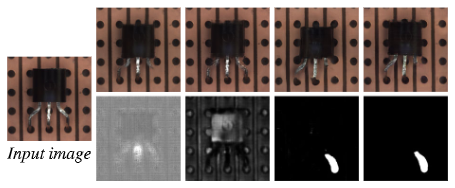Generative Modeling
Generative modeling represents a fundamental class of machine learning models designed to create synthetic data that
closely mirrors real-world data distributions. These models find extensive application in fields such as computer vision,
security, and medicine, where their capability to map image content across domains has demonstrated significant value.
They play a crucial role in automated quality control for industrial processes, particularly in contexts with limited
defective samples due to privacy constraints or operational costs. Nevertheless, challenges such as imbalanced datasets,
mode collapse, and training instability restrict their broader applicability, especially on edge devices. To address
these challenges, we propose novel unpaired image-to-image (I2I) translation models capable of transforming defect-free
images into defective ones while simultaneously generating segmentation masks for defect localization. Furthermore,
combining multiple pre-trained I2I models using a binary-tree structure has been shown to enhance image synthesis quality
and optimize performance for resource-constrained environments. Inspection networks trained on synthetic data produced by
these models show improved accuracy in identifying real defects. Techniques such as weight-sharing and averaging pre-trained
model weights effectively reduce computational resource requirements while maintaining high-quality outputs. Our works also
investigate methods for deploying generative models on low-powered devices, thereby enhancing their scalability and efficiency.
These contributions represent a significant advancement in the practical and industrial applicability of generative models
by improving their performance and adaptability.

Code
https://github.com/pasqualecoscia/SyntheticDefectGeneration